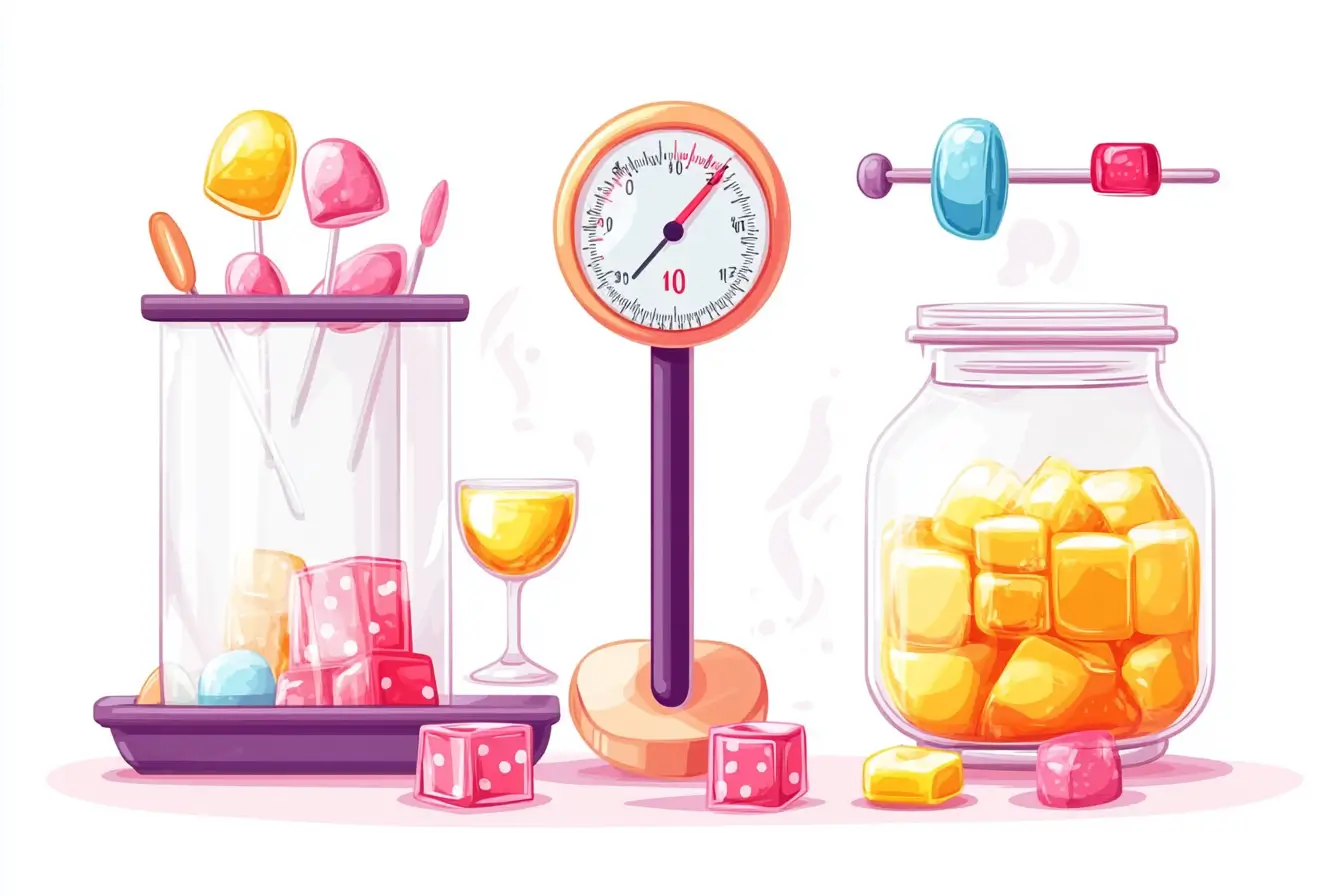If you’re wondering how to fix sticky hard candy, you’re not alone. It’s a common issue, especially for homemade candy enthusiasts or anyone storing sweets in humid conditions. Whether you’re dealing with sticky hard candy straight out of the wrapper or trying to prevent candy stickiness in the first place, there are simple solutions that can save your batch and keep your candy stash in perfect shape.
Whether you’re a candy maker, a candy lover, or someone who just can’t stand sticky messes, this guide has you covered. Let’s talk about why hard candy gets sticky, how to fix it, and how to prevent it from ruining your sweet moments.
Why Does Hard Candy Get Sticky?
Before we jump into the fixes, it’s worth understanding what’s causing the problem. Hard candy goes sticky because of moisture. Here’s a quick breakdown:
- Sugar Loves Water: Hard candy is made of sugar that’s been heated to a super high temperature. When it’s exposed to humidity, sugar starts to absorb moisture from the air, making the candy sticky.
- Improper Storage: If your candy isn’t stored in an airtight container, it’s basically begging to soak up humidity.
- Recipe Issues: Homemade hard candy can turn sticky if the sugar wasn’t cooked to the proper temperature (usually 300°F for “hard crack” stage). Undercooked sugar retains more moisture, and that means stickiness.
How to Fix Sticky Hard Candy
Alright, sticky candy emergency? Don’t panic. Here’s how to save the day:
1. Toss It in Powdered Sugar or Cornstarch
The easiest way to deal with sticky candy is to give it a light dusting.
- What You’ll Need: Powdered sugar or cornstarch.
- How to Do It: Place the sticky candies in a bag with a spoonful of powdered sugar or cornstarch, then shake gently. The powder will coat the candy, reducing the stickiness.
- Pro Tip: Go easy on the powder. You want just enough to create a barrier, not so much that the candy tastes chalky.
2. Reheat and Recoat the Candy
If your homemade candy is sticky because it wasn’t cooked right, you can fix it by reheating it.
- Steps:
- Melt the candy in a saucepan over low heat.
- Bring it back up to the hard-crack stage (300°F).
- Pour it out onto parchment paper or a silicone mat, let it cool, and break it back into pieces.
- Why It Works: Cooking the sugar properly removes excess moisture, making the candy hard and glossy again.
3. Use a Food Dehydrator
Got a dehydrator? It’s not just for jerky and fruit snacks!
- How to Do It: Lay your candy out on the dehydrator trays and set it to a low temperature (around 100°F). Let it run for a few hours to pull out the moisture.
- Bonus Tip: If you don’t have a dehydrator, you can try a warm oven (set to its lowest temperature) for a similar effect.
4. Store It with a Desiccant
If you’re battling sticky candy in storage, adding a desiccant packet to the container can work wonders.
- What’s a Desiccant? It’s those little silica gel packets that come in shoe boxes and electronics. You can also buy food-safe versions.
- How It Helps: Desiccants absorb excess moisture, keeping the candy dry.
How to Prevent Sticky Hard Candy

Now that you’ve fixed your candy, let’s make sure it doesn’t happen again. Prevention is key!
1. Store Candy in an Airtight Container
This one’s a no-brainer, but it makes a big difference. Use a container with a tight seal to keep out humidity.
2. Add a Layer of Wax Paper
If you’re stacking candies, place a piece of wax paper between each layer. This keeps the pieces from sticking to each other.
3. Watch the Humidity
If you’re making candy at home, choose a dry day to do it. Humid weather is your worst enemy when it comes to hard candy.
4. Cook Sugar to the Right Temperature
For homemade candy, a candy thermometer is your best friend. Make sure the sugar hits 300°F (the hard-crack stage) to lock in that perfect texture.
The Role of Temperature in Candy-Making Success
One of the most critical factors in making non-sticky hard candy is reaching the right temperature during cooking. The “hard-crack stage” happens at 300°F to 310°F. If the sugar mixture doesn’t reach this stage, the candy may retain too much moisture, leading to stickiness. This is why a candy thermometer isn’t just a nice-to-have—it’s an absolute must. Without it, you’re left guessing, and trust me, sticky candy happens more often than not when you’re playing the guessing game.
If you’re working without a thermometer, you can try the cold water test. Drip a small amount of the sugar mixture into a glass of cold water. If it forms brittle, hard threads that snap cleanly, it’s ready to pour. If it forms a soft or flexible ball, it needs more time on the heat.
Humidity: The Silent Sticky Candy Killer
Let’s talk about the sneaky role of humidity. Even if you nail the recipe and store your candy perfectly, high humidity can still wreak havoc. This is especially true if you live in a place with muggy summers or rainy winters. The sugar in hard candy naturally pulls moisture from the air, so even a short time in a humid environment can make your candy sticky.
To combat this, try making hard candy on days when the air is dry, or use a dehumidifier in your kitchen. For long-term storage, you can use silica gel packets or desiccants (just make sure they’re food-safe!) to keep the container moisture-free.
Why Proper Cooling Matters
Here’s a step you might not think about: how you let your candy cool. If you pour your candy onto a surface that traps moisture, like wax paper, it could absorb that moisture and turn sticky as it cools. Instead, use a silicone baking mat or parchment paper, which are better at keeping the surface dry.
Let the candy cool completely before you start breaking it into pieces. This helps ensure the texture stays solid and reduces the risk of stickiness. Rushing this step might seem harmless, but trust me—it’s not worth the frustration later.
Common Causes of Hard Cornflake Candy
Hard cornflake candy typically results from:
- Overcooking the Syrup: If the sugar syrup is cooked beyond the optimal temperature, it becomes excessively hard. Using a candy thermometer can help achieve the perfect consistency.
- Ingredient Ratios: The balance of corn syrup, sugar, and peanut butter in recipes like this classic cornflake candy plays a critical role. Excessive sugar or insufficient peanut butter can make the candy hard.
- Improper Storage: Once prepared, storing cornflake candy improperly can lead to texture changes. Learn more about preserving freshness with this comprehensive candy guide.
The Science Behind Powdered Sugar and Cornstarch
You might be wondering why powdered sugar and cornstarch work so well to fix sticky hard candy. It’s all about creating a physical barrier between the candy and the moisture in the air. Powdered sugar contains a small amount of cornstarch, which acts as a natural moisture absorber. Cornstarch on its own is even more effective, especially if you want a “cleaner” look for your candy.
When you coat your sticky candy with these powders, you’re essentially wrapping them in a tiny shield. This doesn’t just reduce stickiness—it also makes the candy more pleasant to handle. Keep this trick in your back pocket for any future sticky sweets, too!
What If You Can’t Fix It?
Sometimes, despite your best efforts, sticky candy just won’t cooperate. Maybe the weather isn’t on your side, or maybe the batch wasn’t cooked quite right. If that happens, don’t toss it out! Sticky hard candy can be repurposed into syrups, decorations, or even a unique baking ingredient. For example, you can crush it and use it as a colorful topper for cupcakes or cookies.
You could also melt it down and pour it into fun molds for a candy “do-over.” Think of it as a second chance to perfect the batch!
FAQs About Sticky Hard Candy
Can I fix store-bought sticky candy?
A: Yep! Toss it in powdered sugar or cornstarch, or use a food dehydrator if it’s really sticky.
My candy thermometer broke—can I still make hard candy?
A: Yes, but you’ll need to use the cold water test. Drop a small amount of your candy mixture into a glass of cold water. If it forms hard, brittle threads, it’s ready.
Why is my hard candy turning cloudy?
A: Cloudy candy usually happens when air bubbles get trapped during pouring. To avoid this, pour slowly and evenly.
How long does hard candy last?
A: Properly stored hard candy can last for months. Just keep it in a cool, dry place.
Is sticky candy safe to eat?
A: Totally! It might not be as fun to eat, but it’s still safe unless it’s grown mold or picked up something gross.A: Totally! It might not be as fun to eat, but it’s still safe unless it’s grown mold or picked up something gross.
Troubleshooting Common Hard Sticky Candy Problems
soft:
- Solution: This usually means the sugar didn’t reach the hard-crack stage. Reheat the candy and cook it a little longer.
sticky:
- Solution: Dust it with powdered sugar, or reheat it to remove extra moisture.
burnt:
- Solution: Unfortunately, burnt sugar can’t be saved. Next time, watch the temperature closely and use a thermometer.
Fun Ways to Use Sticky Hard Candy
Let’s say you’ve tried everything, and your candy is still a little sticky. You can always repurpose it!
- Candy Syrup: Melt sticky candy with a bit of water to create a homemade syrup for cocktails or pancakes.
- Candy Bark: Smash the candy into pieces and use it as a topping for chocolate bark.
- Flavor Boost: Crush the candy and sprinkle it over baked goods for a sweet, colorful touch.
Conclusion
Sticky hard candy might be frustrating, but it’s not the end of the world—or your candy stash. With a few simple tricks, you can fix it, prevent it, and even repurpose it if needed. Whether you’re snacking, gifting, or baking, you’ll never let sticky candy ruin the fun again.


1 thought on “How Do You Fix Sticky Hard Candy? (And Why It Happens in the First Place)”